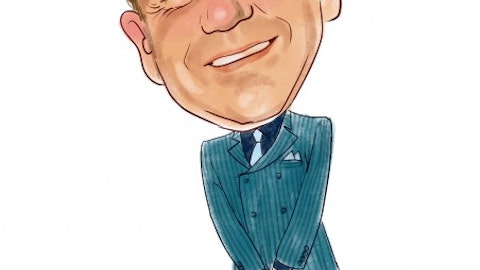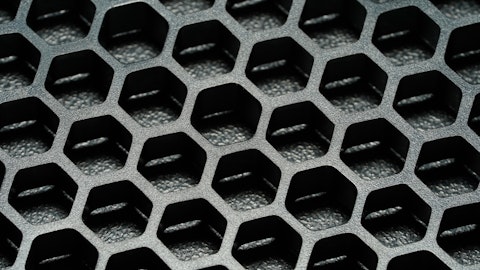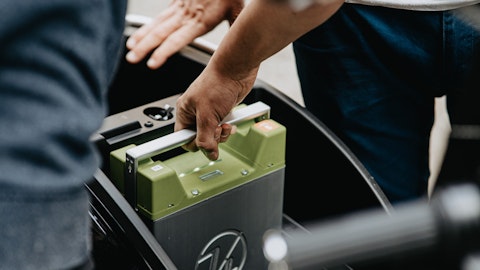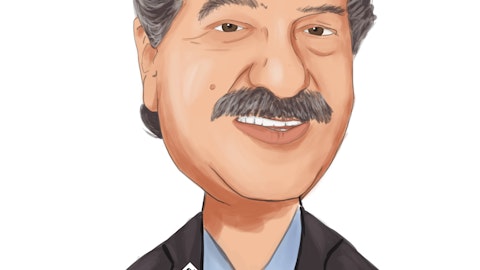Orion Engineered Carbons S.A. (NYSE:OEC) Q4 2022 Earnings Call Transcript February 17, 2023
Operator: Greetings. Welcome to Orion Engineered Carbons Full Year and Fourth Quarter 2022 Earnings Conference Call. At this time, all participants are in a listen-only mode. A question-and-answer session will follow the formal presentation. Please note, this conference is being recorded. At this time, I will now turn the conference over to Wendy Wilson, Head of Investor Relations. Wendy, you may begin.
Wendy Wilson: Thank you, Rob. Good morning, everyone, and welcome to Orion Engineered Carbons conference call to discuss our fourth quarter and full year 2022 financial results. I’m Wendy Wilson, Head of Investor Relations. With me today are Corning Painter, Chief Executive Officer; and Jeff Glajch, Chief Financial Officer. We issued our press release after the market posted yesterday, and we also posted a slide presentation to the Investor Relations portion of our Web site. We will be referencing this presentation during the call. Before we begin, I’d like to remind you that some of the comments made on today’s call are forward-looking statements. These statements are subject to the risks and uncertainties described in the company’s filings with the SEC, and our actual results may differ from those described during the call.
In addition, all forward-looking statements are made as of today, February 17. The company is not obligated to update any forward-looking statements based on new circumstances or revised expectations. All non-GAAP financial measures discussed during this call are reconciled to the most directly comparable GAAP measures in the table attached to our press release. Additionally, when we comment today on EBITDA we will be referring to adjusted EBITDA. I’ll now turn the call over to Cory Painter.
Corning Painter: Thank you, Wendy. Good morning, everyone, and welcome to our earnings conference call. We had a great year in 2022. Many thanks go out to the tremendous Orion team for advancing our sustainability, growth and financial agenda in the face of multiple challenges throughout the year, challenges that we treated as opportunities. We delivered fourth quarter adjusted EBITDA of approximately $65 million, a 25% increase with specialty outperforming our expectations due to the strength of our premium products despite some customer destocking. Moreover, the team delivered record full year adjusted EBITDA of $312 million, our first time breaking the $300 million level. Let me start out by highlighting four key accomplishments.
First, as we mentioned, on our third quarter call, we made substantial progress in the 2023 to 2024 rubber negotiation cycle for price, volume and terms. I say 2023 to 2024 because taking Asia where contracts are structured differently out of the equation, over 50% of our tire volume will be on multiyear contracts. Our progress reflects the customer’s value, our dependability and quality, and that the global supply demand dynamics continue to work in our favor. For example, in North America, underlying demand is increasing due to on shoring of tire production. Couple that with the need for sustainable returns on invested capital, including sustainability capital, we see carbon black capacity remaining tight. I’ll show you more on this a bit later.
Based on pricing alone, we expect rubber gross profit per tonne to increase $80 to $100 in 2023. Second, we achieved a number of sustainability related milestones. We kept our third round U.S air emissions project on track, having recently announced its completion. The project execution environment improved in 2022, but still our people, contractors and suppliers worked around many challenges. We were upgraded by CDP, one of the most serious and respected platforms for environmental reporting to be which is the second highest level. This past week we received our scoring by EcoVadis, one of the world’s most comprehensive rating tools. Our score improved 5 points to 77 earning us a gold medal and putting us in the 99th percentile, a huge improvement from our score 52 in 2018.
We also achieved ISCC certification for our bio-circular grades from three plants. Third, our team increased our dual fuel flexibility in Europe. As of today, we can reduce natural gas usage by about 35% to 40%. The natural gas crisis in Europe may have passed for now, but this provides us with great flexibility as we move forward. Fourth, I am proud to say that the team kept the new plant in China on track despite many challenges. In the fourth quarter, before the COVID zero policy was lifted, COVID finally came to Huaibei, our site was locked out. But with forethought and quick action, we were able to host the construction crew at our plant, meaning they were living at our site. We made sure that workers are well taken care of good food, entertainment and comfortable living accommodations to ensure that worker health and safety were not compromised.
Then, after COVID zero was lifted, we had to work through a huge wave of COVID infections. Thanks to their prompt action and dedication, we remain on schedule and budget and are currently commissioning the facility. With these and several other key items, like our announced expansion of acetylene-based conducted capacity, higher earnings power and increased cash flow. We are on track to a mid cycle adjusted EBITDA capacity of $500 million and are confident in this. With that, I’ll turn the call over to Jeff.

hedgehog94/Shutterstock.com
Jeffrey Glajch: Thank you, Corning. I have quite a few slides with detailed charts and graphs. I will touch on each briefly, but encourage you to spend more time reviewing them. On Slide 4, consolidated full year results were strong with full year revenue, gross profit per tonne and adjusted EBITDA all record highs. Revenue was up 31% to over $2 billion and adjusted EPS grew to $1.96 from $1.73 in 2021. This slide provides some key full year metrics for our rubber and specialty businesses. I will talk in depth about each business shortly. On Slide 5, you can see the consolidated key factors for the full year 2022. The base price improvements and mix gains across both businesses far outweigh the lower volume which occurred in specialty only.
In fact, rubber volume was up 3% in the year. We have a strong FX headwind in 2022, as the average euro to dollar exchange rate went from 118 to 105. The full year EBITDA increase of $44 million occurred despite this $26 million FX headwinds. On Slide 6, looking at Q4, despite a small decline in volume, our continued strong GP per tonne helped us achieve a 25% EBITDA increase and an adjusted EPS increase of over 40%. Slide 7 provides some additional insight of the drivers for Q4 adjusted EBITDA. We continue to see the benefit of base pricing and mix in both businesses and high cogeneration profitability. On Slide 8, looking at specialty and Q4, volumes decreased as we expected, reflecting weaker global and market demand and customer destocking.
However, revenue was flat due to improved price realization and mix offset by the aforementioned lower volume. Adjusted EBITDA decreased 18%. Note that gross profit per tonne continues to be strong, both in the quarter and the trailing 12 months. You may recall that at our Investor Day, Corning shared that the earnings power of our highest value, most differentiated specialty products had an EBITDA capacity above $80 million at 40% EBITDA margins. This part of our portfolio delivered as expected in 2022, and this along with price realization and the positive impact of new products helped to improve our per tonne margins by over 20% compared with Q4 last year. Slide 9 shows the key factors affecting adjusted EBITDA for the specialty business compared to last year.
As noted earlier, volume reduction was significant, particularly in low value products. The volume decrease was nearly offset by improved pricing and mix as well as higher cogeneration benefits. Slide 10 looks at the rubber business in Q4 with improvements to all metrics on a year-over-year basis. Volume increased in the Americas and APAC, specifically in China and Korea as we believe customer customers valued our reliability and quality. We also continue to benefit from strong pricing. Gross profit per tonne was $350 in the quarter. We continue to see a nice upward trend in our trailing 12-month gross profit per tonne now at 336, up sharply over the past 2 years. This reflects the 2021 pricing cycle, which was driven by our requirement to begin to achieve an acceptable return on our air emissions quality — our air emissions control related capital and operating costs.
As Corning noted, we expect another significant step up in 2023, with price alone expected to move our GP per tonne well above $400. Slide 11 shows the key factors affecting adjusted EBITDA for the rubber business. Strong base pricing and mix were all favorable as was cogeneration income. Before I pass the call back to Corning, I’d like to provide an update on our stock buyback program that we announced in November. Today, we have repurchased over 800,000 shares, which is approx — which was approximately 1.4% of the shares outstanding. We have spent approximately $16 million or nearly one-third of the approved $50 million authorization. As I noted on the call in November, we expect this buyback to be completed in a couple more quarters likely sometime later this summer.
I will turn the call over to Corning to discuss our 2023 guidance, capital expenditures and cash flow expectations and comment on our multiyear growth path.
Corning Painter: Thanks, Jeff. Turning to Slide 12. Despite the uncertainties in the global economy, we are confident in our business and our establishing guidance for 2023 of $350 million to $380 million, up 17% at the midpoint. We provide a split of our guidance for our two business segments. This is not something we would normally provide, but we believe it is particularly helpful for 2023. Note that we have bracketed our 2023 rubber EBITDA figure from what we shared last quarter. This reflects a softening in our projection of miles driven. If European power rates moved up or down by about 20%, the impact on our P&L of all the gives and takes would be about $10 million. Our adjusted EPS guidance range is $2.30 to $2.60 a share, up 25% at the midpoint.
We plan to invest approximately $235 million in capital spending. Let’s move to Slide 13, and I’ll provide some additional color on that. With our third plant now online, we only expect to have about $25 million of U.S air emission controls spending less for our final project. This will probably be the last time we speak about U.S air emission control spending as it will no longer be particularly significant. And as that spending tapers off, we expect to have the bandwidth and cash flow to take on some of our backlog of smaller, high value projects. The slide shows the components of 2023 spending, we’ve also given you some color commentary for modeling purposes. As shown on Slide 14, we expect significant discretionary cash flow of $200 million to $240 million and free cash flow bracketed around $100 million.
As our cash flow increases, we will balance our capital allocation decisions between investing in high value projects, lowering debt and returning cash to shareholders. Looking at Slide 15, we believe that the intrinsic value of the company and our projected cash flows greatly exceeds our share price. With our value creation mindset earned pricing and steady progress on our projects, we are confident that we have the building blocks in place to make a step change in our cash flow and adjusted EBITDA to reach our 2025 goals. Now before I wrap things up, I want to point you to Slide 16. As I mentioned earlier in the call, we firmly believe that our rubber business gains are baseline from which we can grow. The fact remains that demand continues to outstrip supply for rubber carbon black in many of our key markets.
You can see clearly that North America, the supply demand balance has shifted over time, and we expect it to continue to be tight for years to come. Underlying demand in North America is increasing due to plant on shoring of tire production, while high carbon black investment costs to secure a significant new carbon black capacity. In Europe, the situation is complicated by the war and its impact on Russian supply to Europe. Significant amounts of Russian carbon black continue to flow into Europe and remain in some customers supply chain even at some of it now flows to China. For this reason, coupled with an increase in European tire capacity, we believe the European carbon black market will tighten further. In closing, I would ask you to consider a few thoughts.
First, 2022 was a record year for us and I believe 2023 is going to be even better. Second, since becoming a public company, we have grown through periods of low oil prices as well as high oil prices, and we have demonstrated through those periods how resilient the business is. We are a specialty chemical company and we are determined to achieve a specialty valuation. Third, due to continued supply demand imbalances for rubber carbon black, we believe our rubber contract pricing and terms are the new baseline. Fourth, our team has proven their dedication and agility during challenging times. We have momentum in sustainability, in our markets, in our new products and with our customers. The Iranian team is well-positioned not only for 2023, but for years to come.
Finally, considering all these factors, we are well on our way to significantly increase earnings and free cash flow in line with our 2025 mid-cycle earnings and cash flow capacity goals. The foundation that we have laid over the past few years is now evident in our financial results and outlook. Thank you. Operator, please open the line for questions now.
See also Dividend Challengers List Ranked By Yield and 16 Largest Photography Companies in the World.
Q&A Session
Follow Orion S.a. (NYSE:OEC)
Follow Orion S.a. (NYSE:OEC)
Receive real-time insider trading and news alerts
Operator: Thank you. And our first question comes from the line of Josh Spector with UBS. Please proceed with your questions.
Josh Spector: Yes, hi. Thanks for taking my question. And firstly, I guess, congrats to you and the team on a pretty solid end to 2023 here, a lot of big accomplishments.
Corning Painter: Thank you, Josh.
Josh Spector: My first question — yes, you’re welcome. So first question, Jeff, in specialty, your guide is kind of close to annualizing fourth quarter. And I mean, clearly, that’s a quarter pretty challenging volumes down 20% plus year-over-year. Most companies are saying don’t annualized fourth quarter, it’s not the right run rate. When I look at some of the things you guys have new capacity coming online, you have maybe some raw material costs coming down. So I’m just wondering, what’s your bridge to basically flat to slightly up in specialty next year from where we are today?
Jeffrey Glajch: Well, first of all, I’d say our forecast is more like second half repeating going into this year. I think the markets in China are still pretty challenging, even though COVID zero policy is still behind us. So that’s kind of how we see it right now and when we talk to our customers.
Josh Spector: Okay. I guess maybe I dig in a bit more there is what should we be assuming for Huaibei? And what terms of when that comes online and the contribution there? Any changes from your prior comments?
Corning Painter: So I think Huaibei and in specialty, in particular, there’s going to be a qualification period associated with that. So I think we’d see more of that contribution in the second half. We are in startup right now. So you could say there would be qualification volumes going out into the second calendar quarter, and you start to see more of that loading in the second half.
Josh Spector: Okay. And then if I could just ask on, I mean, I think Slide 16 was pretty interesting on the supply demand. I don’t know if we’ve really seen a sustained under supply. So what happened, happen in North America? Are prices still not at a point where you’d see incremental investment closing that gap to prices move up? Is there demand destruction? What’s the scenario you see playing out?
Corning Painter: Well, if you look at our curve, we do see some incremental investment going on, right. The situation with is well understood, very — a lot of capital going into that additional capacity that is there. I think that creates a bit of an overhang from anyone wanting to make further investments as well as just an assessment there’s some other very attractive areas, for example, in conductive carbons. So I think the U.S market is going to remain tart — tight. I think what we achieved this year is, as I said in the call, like the new foundation, the new base, I do think there’s upside front.
Josh Spector: Okay, thank you.
Operator: The next question comes from the line of Laurence Alexander with Jefferies. Please proceed with your questions.
Laurence Alexander: Good morning. So I guess just a couple of follow on to that. So first, when we look at the specialty business, the gross profit per tonne improved by about $120 million, $130 million year-over-year, in a pretty soft environment in China and Europe. What do you think gross profit per tonne will do in a synchronized global recovery or acceleration period?
Corning Painter: So one element of that, just keep in mind — just correct me, it was one up about $130 per tonne, I think this is the point that you need to make, or that you attended to make there. So a big element, and our GP per tonne is always going to be mixed. And so what you see here is the great strength in like our most differentiated products. When we see volume coming back in areas like masterbatch and so forth, will have an advantage in terms of greater loading and absorption of fixed costs. But we also see a little bit of the dilutive impact of it. So I think if we were going to say in the $800, $900 range for GP per tonne is probably a fine number in terms of modeling. Jeff, do you want to add anything to that?
Jeffrey Glajch: I think that makes sense. I think if you look at the weighted average of as we see volume coming back in, we could see the GP per tonne in 2023 actually lower than 2022 just because of the low end volume, as you noted.
Laurence Alexander: Right. And then secondly, given you have already have contract — price contracts extending into ’24, can you give a sense for how much net tailwind you already have baked in ’24, just in the contracts you’ve already signed?
Corning Painter: I see that it’s somewhat commercially sensitive what we have in them. We do have upside going into ’24.
Laurence Alexander: Okay. And then lastly, $450 million of free cash flow on your mid cycle estimates over the next 3 years, can you give a sense for sort of capital allocation, possibility of adding the bolt-on M&A or adjacencies, or kind of how you’re thinking about what that flexibility implies for what you can do next?
Corning Painter: So we look at this and aspire to always have a range of options open for us where we’ve done the work to create so-called real option, buying that settling plant years ago, it took years of work to get it up to lithium ion battery standards, but we’re there. And then that creates the option to do something like what we’re doing in right now. So when we look at that, we will make a decision balancing out between returning more cash to shareholders, between continuing to invest in expansions, let’s say, debottlenecking that kind of an expansion in our core business as well as opportunities for other growth, which could be something that’s a very, very near adjustment. It could be doing more simply in the connectivity space where we are right now.
I think there’s really a variety of options open to us, Laurence, for growth. And at this point, we’re enjoying having those options. We’re going to be very careful stewards of this capital, spend it well, it’s the shareholders money, not ours, and just leave ourselves those options for right now.





